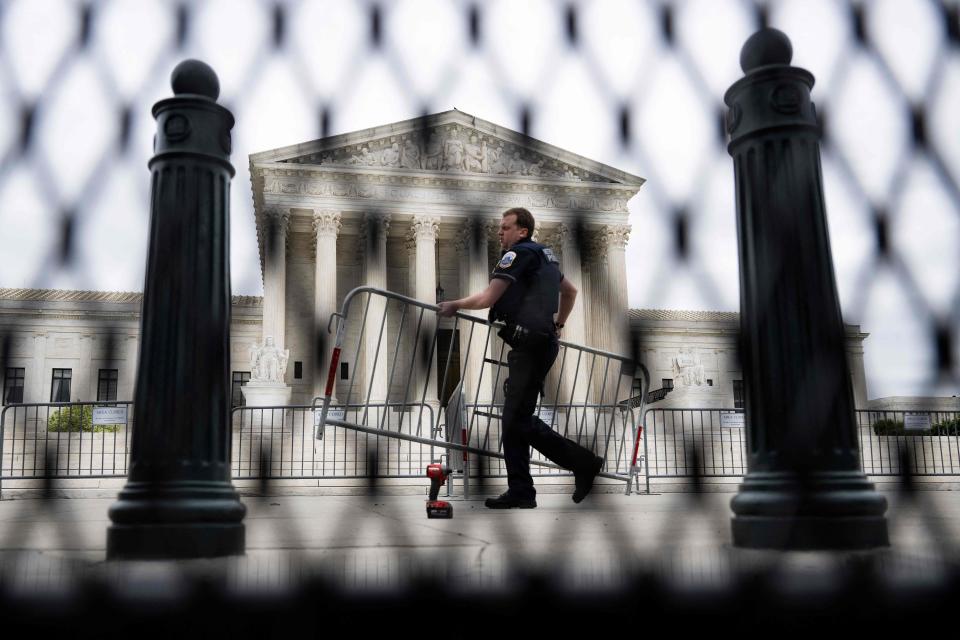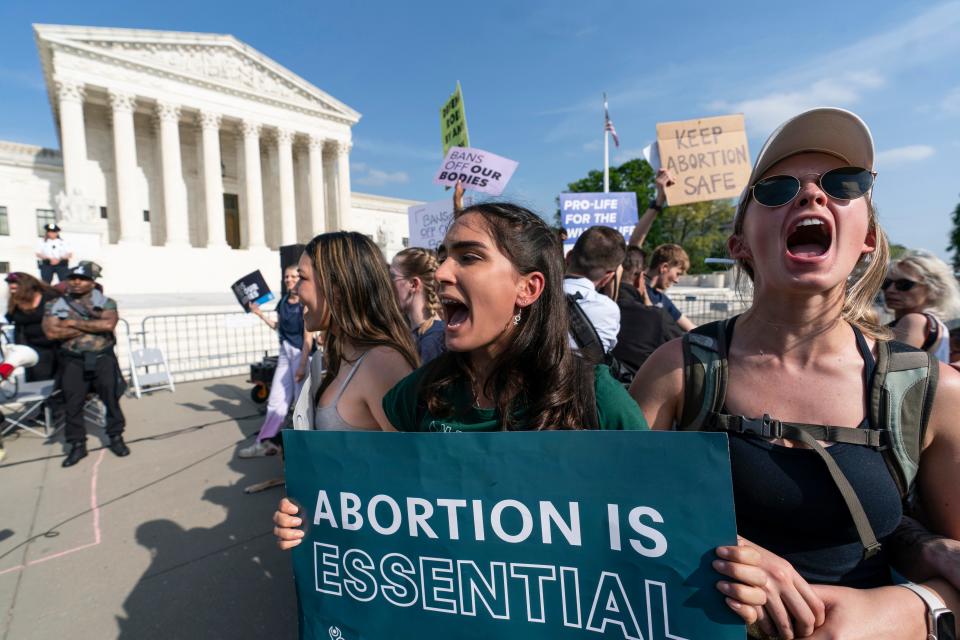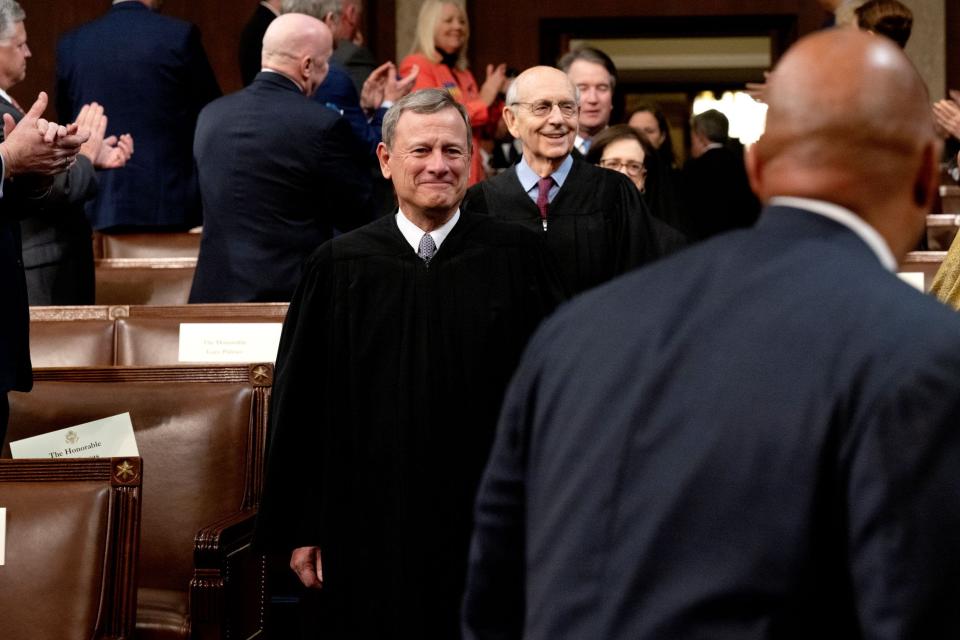The Supreme Court has overruled itself on segregation and saluting the flag. Will Roe be next?
- Oops!Something went wrong.Please try again later.
WASHINGTON – When the Supreme Court rules, it's the law of the land – until it isn't.
The revelation this week that the nation's highest court is considering an opinion that would overturn its landmark 1973 abortion case, Roe v. Wade, underscored that what millions of Americans learned in school about the Supreme Court honoring precedent set down in past cases is not a hard-and-fast rule.
It is true that the high court rarely overturns decisions. The principle of stare decisis – the adherence to earlier decisions – gives stability to the law. Another way to put it: The justices generally prefer to let the other two branches of government respond to political passions.
The idea, said Frederick Schauer, a professor at the University of Virginia School of Law, is to think of courts "as brakes and not as accelerators."
But as the Supreme Court itself has often said, honoring precedent is not an "inexorable command." If a majority of justices conclude a case was wrongly decided, if that precedent has proved "unworkable," if Americans haven't come to rely on the prior decision or the facts have changed, it may go.
That, Schauer said, is a more common outcome than many realize.
Whodunit? Speculation swirls as Supreme Court launches probe into leaked opinion
LGBTQ: Could rights to same-sex marriage, contraception be next?
Shaken: Leaked abortion opinion shakes trust in Supreme Court
"I wish it were otherwise," Schauer said of adherence to stare decisis. "I wish the Supreme Court were more observant of it. But across the political spectrum on both sides of the aisle, for decades, they haven't been taking it seriously."
In a stunning breach of protocol, a leaked draft of Associate Justice Samuel Alito's opinion overturning Roe was published by Politico on Monday. The Supreme Court verified the authenticity of the draft but said it was not the final opinion.
"Roe was egregiously wrong from the start," Alito wrote. "We hold that Roe and Casey must be overruled."
A 7-2 majority concluded in Roe that people have the right to an abortion during the first and second trimesters but that states could impose restrictions in the second trimester. Years later, in Planned Parenthood v. Casey, the court maintained Roe's "central holding" of a constitutional right to abortion but threw out the trimester framework.
Instead, the court ruled, states could ban most abortions after viability, the point at which a fetus can survive outside the womb – roughly 24 weeks.
"The judgment in Casey," Alito asserted in his draft, "did a fair amount of overruling."
When it comes to abortion, the conservative justices have been keen to note other precedents that were overturned. In December, during oral arguments in the abortion case, Associate Justice Brett Kavanaugh read a litany of examples. In the leaked opinion, Alito included a page-long footnote citing others.
Abortion rights advocates counter that in most of those situations, the court expanded rights rather than took them away. Here's a look at some of the Supreme Court's most significant decisions that overturned – or reconsidered – precedent:

Plessy, Brown and school segregation
When Americans – including Supreme Court justices – talk about the court's power to overturn precedent, the first case they cite is almost always Plessy v. Ferguson. Decided in 1896, about three decades after the end of the Civil War, a 7-1 majority of the court ruled that a Louisiana law that required separate rail cars for Black and white passengers did not violate the Constitution – a decision that ushered in decades of what became known as the "separate but equal" doctrine throughout the nation.
It took nearly six decades before the Supreme Court overturned Plessy in a case widely celebrated as one of its most important, Brown v. Board of Education. In 1954, a unanimous court held that segregation had no place in public schools. It took years more – and a showdown between President Dwight Eisenhower and the school board of Little Rock, Arkansas – before the court's command in Brown was enforced, though education experts point to a de facto segregation in many American schools today.
Graphic: What did Roe v. Wade actually say? The landmark abortion ruling explained
Overseas: Why the Supreme Court may look to China as it reconsiders Roe v. Wade
Secrecy: Supreme Court deliberations are supposed to be secret. What happened?
"We conclude that, in the field of public education, the doctrine of separate but equal has no place," Chief Justice Earl Warren wrote for the court in an opinion that reshaped race relations. "Separate educational facilities are inherently unequal."

Lochner and workplace conditions
In 1905, the Supreme Court’s decision in Lochner v. New York gave rise to a series of cases – and a way of thinking about business regulations – that has been repudiated. At issue was a New York law that set maximum work hours at bakeries – for instance, limiting a baker’s daily workday to 10 hours. A 5-4 majority invalidated the law, holding that the Constitution prohibited "unreasonable" interference with the power of employers and employees to negotiate workplace conditions.
Relying in part on Lochner, the court struck down several regulations intended to improve the workplace during the Great Depression.
That controversial approach was abandoned in West Coast Hotel Co. v. Parrish in 1937, a 5-4 decision upholding Washington’s minimum wage law after a maid at the hotel sued for more pay. Associate Justice Owen Roberts' decision to side with the majority became known as the “switch in time that saved nine,” as President Franklin D. Roosevelt – fed up with the high court’s hostility toward his New Deal policies – pushed to expand the size of the court from nine justices to as many as 15.

Freedom of conscience and saluting the flag
In 1940, days before Paris fell to Nazi Germany and a year before the United States entered World War II, an eight-justice majority of the Supreme Court upheld a state regulation in Pennsylvania that required public school children to salute the U.S. flag while reciting the Pledge of Allegiance – despite religious objections from two young students who were Jehovah's Witnesses. In part, the court asserted that the state's regulation was intended to "awaken in the child's mind" the significance of the flag.
The case, which Alito references in his draft abortion opinion, is notable for how quickly the court reversed itself. Three years later, the court ruled in a 6-3 decision that the requirement ran afoul of the Constitution.
"This case calls upon us to reconsider a precedent decision, as the court, throughout its history, often has been required to do," Associate Justice Robert Jackson wrote.
"If there is any fixed star in our constitutional constellation, it is that no official, high or petty, can prescribe what shall be orthodox in politics, nationalism, religion, or other matters of opinion, or force citizens to confess by word or act their faith therein," he wrote.
Korematsu and Japanese internment
In what is widely viewed as one of the Supreme Court’s most ignominious decisions, a 6-3 majority upheld a presidential order in 1942 that required Japanese Americans to leave "exclusion zones," defined by the military, after the bombing of Pearl Harbor. Fred Korematsu defied the order. The Supreme Court upheld his criminal conviction but declined to delve into the issue of Japanese internment.
In another decision handed down on the same day, the court unanimously ruled that the Roosevelt administration could not continue to detain citizens who were "concededly loyal" to the United States.
The Supreme Court never technically overturned Korematsu, but Chief Justice John Roberts rebuked the decision in 2018 in a case dealing with President Donald Trump’s travel ban on a handful of mostly Muslim nations. “Korematsu was gravely wrong the day it was decided,” Roberts wrote in the court’s majority opinion, “has been overruled in the court of history, and – to be clear – ‘has no place in law under the Constitution.’”
Bowers, Lawrence and same-sex marriage
There have been some recent examples as well, including some that vastly expanded the rights of LGBTQ Americans. In 1986, a 5-4 majority ruled in Bowers v. Hardwick against a Georgia man convicted of having sex with another man inside his home. After all, the court concluded, nothing in the Constitution explicitly conferred a right to homosexual intercourse.
In a landmark case in 2003, Lawrence v. Texas, the high court confronted a similar set of facts and reached the opposite conclusion. The 6-3 decision, written by Associate Justice Anthony Kennedy, was based in part on the idea that the Constitution's promise of liberty meant the government shouldn't have a role in "certain intimate conduct."
The state, Kennedy wrote, "is not omnipresent in the home."
Honoring precedent "is essential to the respect accorded to the judgments of the court and to the stability of the law," he wrote. "It is not, however, an inexorable command."
A dozen years later, a 5-4 majority of the Supreme Court legalized same-sex marriage. Though the decision in Obergefell v. Hodges didn't overrule a Supreme Court precedent, it did end a legal battle that had brewed in the states for more than four decades after the Supreme Court declined to hear an appeal of a state supreme court decision against same-sex marriage licenses.
This article originally appeared on USA TODAY: Can Supreme Court cases be overturned? Roe latest to test precedent

